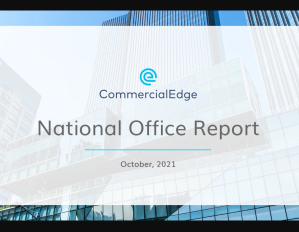Office Supply Boom Drives Up Vacancy
Highlights of CommercialEdge’s latest report include a significant year-over-year jump in the national rate.
 Companies are once again adjusting return-to-office plans amid renewed uncertainty spurred by the COVID-19 delta variant. However, a silver lining has emerged due to mandates which increased vaccination rates across the country, alongside the possibility of an antiviral that alleviates coronavirus symptoms.
Companies are once again adjusting return-to-office plans amid renewed uncertainty spurred by the COVID-19 delta variant. However, a silver lining has emerged due to mandates which increased vaccination rates across the country, alongside the possibility of an antiviral that alleviates coronavirus symptoms.
Big tech companies act once more as a trend-setters in terms of post-pandemic office utilization; Google announced its intention of purchasing St. John’s Station in Manhattan’s Hudson Yards, Amazon has been moving forward with construction of its second headquarters in Northern Virginia, while Apple paid $450 million for three buildings to expand its office footprint in Cupertino, Calif.
National average full-service equivalent listing rates clocked in at $38.62 per square foot in September, 10 cents lower than the month prior but up 120 basis points year-over-year. Similarly, the national office vacancy rate was 14.9 percent, 130 basis points higher year-over-year as of September but 50 basis points lower than in August 2021.
While most markets recorded slight decreases in vacancy compared to the previous months, these had significant increases on a year-over-year basis, largely due to recent supply booms. These changes were most evident in Austin (510-basis point vacancy rate increase over the last 12 months, 15.0 percent of stock delivered since 2017), San Francisco (510 basis points, 11.2 percent) and Nashville (490 basis points, 15.4 percent).
The office-using sector added 94,000 new jobs in September, up 4.2 percent year-over-year. Office-using sectors make up 22 percent of the total labor market but encompassed nearly half of the job growth the month before. Despite these positive numbers, office jobs haven’t reached pre-pandemic levels. Only twelve of the top 50 markets covered by CommercialEdge have more office-using employees than in February 2020, with Austin, Nashville and Miami leading the way.
The active pipeline totals some 158.2 million square feet of office space, with 70 percent of it located in urban areas or Commercial Business Districts. This highly urban pipeline reflects pre-pandemic trends. More than 36.2 million square feet of new supply has been completed year-to-date in September, a dramatic drop from the same period last year, when 87.2 million square feet of office space broke ground. Development activity was highest in Austin (10 percent of total stock), Nashville and Boston (5.4 percent).
Read the full CommercialEdge report, here.







You must be logged in to post a comment.